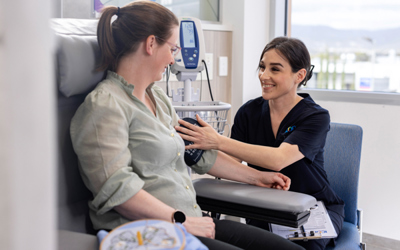Quick facts about chronic myeloid leukaemia
Chronic myeloid leukaemia (CML) starts when the bone marrow produces an excess of white blood cells that grow and spread abnormally
These white blood cells are called granulocytes. They are a type of myeloid blood cell that move through a large network of tissues and organs called the lymphatic system and impact areas such as the lymph nodes, spleen and liver
Chronic leukaemia can develop slowly and may take months or years for symptoms to develop
CML is more common in older people and very rare in children under 15. Around 750 people are diagnosed with CML each year in the UK.
Types of chronic myeloid leukaemia
All cases of CML have a chromosomal abnormality called the Philadelphia chromosome. Your cells contain 23 chromosomes and the Philadelphia chromosome develops in chromosome 22 when part of chromosome 9 joins onto it. This new type of chromosome contains the BCR-ABL gene that tells leukaemia cells to grow and spread.
Signs and symptoms of chronic myeloid leukaemia
As signs and symptoms for CML can be similar to other common conditions, it’s important to see your GP or healthcare professional if you experience any of the symptoms below. In many cases, these symptoms may not show for months or years after developing CML. Discussing anything concerning with your doctor as soon as possible can help give you peace of mind and offer the best chance of successful treatment if you receive an CML diagnosis.
Although CML has no symptoms in many cases and is often diagnosed during routine blood tests, symptoms may include:

Tiredness

Anaemia, including dizziness, paleness and shortness of breath

Night sweats

High temperature

Unexplained weight loss and loss of appetite

Bone pain

Enlarged abdomen and feeling full after eating a small amount

Increased bleeding and bruising
Stages of chronic myeloid leukaemia
Unlike other cancers, CML is classified into phases rather than stages. These phases are based on the number of immature white blood cells in your bone marrow and blood.
-
Chronic phase
This phase can last many years and is when most people are diagnosed. During this phase the blast cell (immature cells) numbers in the blood and bone marrow are low (< 5%), which means the phase is relatively stable. There are few (if any) symptoms in this stage.
-
Accelerated phase
During the accelerated phase, the number of blast cells start to increase in the bone marrow and blood.
-
Blast phase
The blast phase is a period of rapid progression where blast cell numbers in the blood and bone marrow increase quickly. Symptoms often worsen and the patient is considered to have a form of acute leukaemia.
Treatment for chronic myeloid leukaemia
There are many different types of treatment for chronic myeloid leukaemia. Your treatment will depend on you and your cancer.




